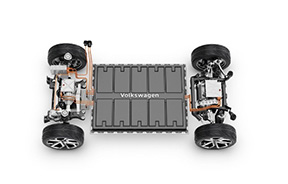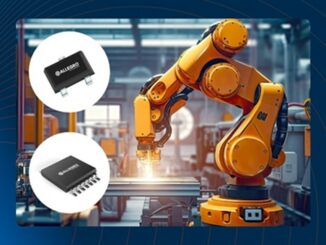The automotive industry is dramatically increasing its commitment to electric vehicles, leading to a transformative shift in its supply chain that has broad implications for the magnetics industry. Most significantly, the new levels of commitment to EV production will translate to higher production of permanent magnet motors but also technology improvements in the enabling components, systems and materials involved.
 Undercover in South Africa. Volkswagen pans to reinvent itself with the ID. family of electric vehicles, shown here under stealth wraps in recent test drives through South Africa. At the end of 2019, the first model based on the modular electric drive matrix goes into production.
Undercover in South Africa. Volkswagen pans to reinvent itself with the ID. family of electric vehicles, shown here under stealth wraps in recent test drives through South Africa. At the end of 2019, the first model based on the modular electric drive matrix goes into production.
The automotive industry is dramatically increasing its commitment to electric vehicles, leading to a transformative shift in its supply chain that has broad implications for the magnetics industry. Most significantly, the new levels of commitment to EV production will translate to higher production of permanent magnet motors but also technology improvements in the enabling components, systems and materials involved.
Key targets for these developments include new motor and powertrain designs along with advancements in electrical steel, magnets, alloys and inductive charging to enable tomorrows EVs to be lighter and go farther under battery and hybrid power.
Electric and hybrid-electric automobiles are driving the transformation, but buses and trucks are following in step to create a profound long-lasting change in automotive transportation and the magnetic components at work under the hood.
The trends for electric vehicle adoption in the automotive industry indicate a tipping point has been reached. Concept vehicles are moving into the factories as automotive manufacturers and their suppliers prepare for a new future where electric vehicles make up a fast-growing, significant share of the vehicle mix worldwide.
Shifting Gears to Electric Vehicles
The car industry is undergoing a radical transformation, with most carmakers agreeing the next 10 years will bring more change than the two previous decades. The next target date cited by automakers as a tipping point is 2025, when everything from materials and fuel to cost and the companies that build cars are set to look dramatically different concludes J. P. Morgan Research, in its recent report, Driving into 2025: The Future of Electric Vehicles.
According to the report, automakers are preparing to phase out cars powered solely by internal combustion engines (ICE) as governments look to tackle fuel emissions. The growth in electric vehicles and hybrid electric vehicles (HEV) is climbing and by 2025, EVs and HEVs will account for an estimated 30% of all vehicle sales. Comparatively, in 2016 just under 1 million vehicles or 1% of global auto sales came from plug-in electric vehicles.
By 2025, J.P. Morgan estimates this will rise close to 8.4 million vehicles or a 7.7% market share. While this jump is significant, it doesnt compare to the kind of growth expected in HEVs – cars that combine a fuel engine with electric elements. This sector is forecast to swell from just 3% of global market share to more than 25 million vehicles or 23% of global sales over the same period.1 This leaves pure-ICE vehicles with around 70% of the market share in 2025, with this falling to around 40% by 2030, predominantly in emerging markets.
Automakers commit to more EVs
Recent announcements from auto makers about their plans for shifting to a higher percentage of EV production are stacking up. At the head of the list is Volkswagen. Rebounding from its fall from grace over emissions violations, Volkswagen has embarked on a major push to manufacture millions of reasonably-priced, all-electric cars underpinned by a full-system, comprehensive string of innovations in EV design and manufacturing technology.
In its report, Global Electric Vehicle Market Outlook, 2018, market research firm Frost & Sullivan tallies up the roster. Porsche aims at making 50% of its cars electric by 2023. Jaguar-Land Rover has announced it will shift entirely towards electric and hybrid vehicles by 2020. General Motors, Toyota and Volvo have all declared a target of 1 million in EV sales by 2025. Aston Martin expects that EVs will account for 25% of its sales by 2030, with the rest of its line up comprising hybrids. BMW says that it plans to offer 25 electrified vehicles, of which 12 will be fully electric by 2025. The Renault Nissan & Mitsubishi alliance intends to offer 12 new EVs by 2022, according to the report. Tesla, meanwhile, continues with its ambitious plans for rolling out its own models.
 Jaguar I-PACE
Jaguar I-PACE
The electric drive system of the Jaguar I-PACE uses two permanent magnet synchronous motors, each rated at 197 horsepower for a total of 394 horsepower. Similar to Teslas model X and to Volkswagens new EV designs, the motors are located at the front and rear axles. Each motor produces a maximum of 256 lb-ft of torque and both motors operate all the time to create permanent four-wheel drive.
Reinventing Volkswagen
Volkswagen is zealously planning to reinvent itself with its ID. family. The first model based on its modular electric drive matrix (MEB) will go into series production at the end of the coming year and then roll out to dealerships and customers at the beginning of 2020. Unlike many of its competitors, Volkswagen is not targeting one of the larger models to start, with successive shrinking then in electrified volume segments. Rather the company’s plan is to launch its all-electric offensive at the heart of the brand with the ID. compact class model.
Now, about one year before the start of production of the fully electric ID., Volkswagen has announced further details of its electric offensive. Throughout the group, up to 15 million vehicles based on the MEB are to be built in the first wave, compared with 10 million vehicles according to previous plans. Up to 2023, the brand will be investing more than 9 billion in the ID. The first model will be the compact ID. It will be produced from the end of 2019 at the companys Zwickau plant, which is currently being transformed into the highest-performance electric car factory in Europe, the company says. By 2025 at the latest, the brand intends to sell 1 million electric cars per year throughout the world.
 Volkswagen MEB
Volkswagen MEB
These are Volkswagens in a variety of classes which have been designed as full electric vehicles and reach ranges of up to 500 km and more. The architecture of the MEB will fundamentally change electric cars and cars in general, the company asserts. Its concept is to jettison all the ballast of the fossil age as it has been designed consistently from the ground up as an all-electric platform, not a platform for vehicles with combustion engines that has been retroactively modified. This leads to fundamental changes in body design, interior design, the package and the powertrain characteristics of electric Volkswagens.
Its Vizzion model set for launch in 2022 will feature an electric all-wheel drive system with two electric motors and 225 kW system output with an operation range of up to 665 kilometers. It is positioned as a higher-end model competing more directly with Tesla offerings.
 Volkswagen Vizzion
Volkswagen Vizzion
The ID will be a milestone in technological development, said Christian Senger, the head of VWs e-mobility product line. It will be the first fully connected electric car with full everyday utility that millions of people will be able to afford.
Overall, VW said it predicted sales of 10 million electric vehicles across the group based on the MEB for its first wave of models, which will include compact cars and SUVs. Lately, the company has indicated that it is planning to product 50 million EVs and deliver price declines in the range of 40% from the level of comparable EVs on the market currently, bringing in new EV development across other of its brands such as Audi and Skoda.



